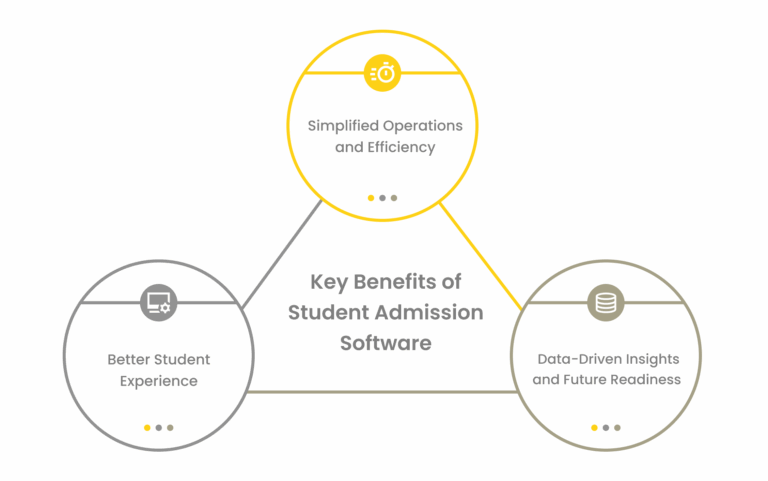In Australia’s education market, institutions across all levels, universities, TAFEs and RTOs are using student admission software to streamline their enrolment process. Student admissions platforms are a must have for managing high volumes of applications. Digitizing enrollment processes speeds up operations for educational institutions and provides applicants with a smoother, more convenient application experience.
Simplified Operations and Efficiency
One of the biggest advantages of student admission software is that it simplifies administrative workflows. Instead of relying on paper forms and spreadsheets, using an integrated admission system saves time and reduces errors. Many institutions still operate with traditional systems that overburden staff and increase costs, whereas student admission software manages repetitive tasks and data entry more accurately. By automating processes like application sorting, document collection, and eligibility checks, admission teams can focus more on strategic and value-driven activities rather than paperwork.
Digital admissions platforms also help bust application processing bottlenecks, keep the applicant pool flowing. Instead of files piling up in a first in first out queue, automation can prioritise and route applications to available staff, so no delays. Faster processing not only boosts internal productivity but also prevents applicants from bombarding staff with status queries . Overall a modern admissions system allows Australian education providers to handle large volumes of enquiries and applications quickly and accurately, so no student falls through the cracks during peak periods. Student Management System simplifies all major administrative processes, from initial admissions to student success strategies, and keeps records in order. It makes everyday tasks faster and frees up staff to focus on growth or educational goals. In practice, this means that admission officers can spend more time with prospective students or refining recruitment strategies, rather than shuffling papers. The result is a leaner
Better Student Experience
The biggest advantages of student admission software is that it improves the overall applicant experience, whether they are university students or TAFE applicants. Today’s students expect convenience and quick access. They are accustomed to finding information with just a few clicks and expect to be able to apply online.
Modern student admission systems meet this expectation through user-friendly online portals available 24/7. Applicants can fill out forms, upload documents, and even save their progress to complete later — all from the comfort of their homes. These systems also allow students to complete applications and payments in a single step, removing the need for paper forms or in-person visits. This is especially important in Australia, where applicants are often spread across large distances or applying from overseas. A good student admission platform also keeps applicants informed and engaged throughout the process. Automated email or SMS notifications can instantly update candidates on application status, required documents, or offer letters. This transparency reduces stress and builds trust. Online tracking further gives students and families a clearer view of their progress.
Since the application process is often a student’s first significant interaction with an institution, a smooth digital experience creates a positive first impression. While slow, complex, or paper-based processes can turn applicants away, a fast and easy-to-use system signals that the institution is student-focused and modern. Experts suggest that admission systems are an integral part of the student experience and should leave a positive impact on applicants. In competitive situations where students have multiple offers, they tend to choose institutions that simplify the process and make them feel valued. In short, student admission software helps remove potential barriers during the application stage, attracts more students, and increases the likelihood of converting applicants into enrolled students through a strong pre-enrolment experience.

Data-Driven Insights and Future Readiness
Specialised student admission software provides Australian education providers with extensive data and analytics to support decision-making and strategic planning. By centralising all application data in one place, institutions can easily track trends such as the number of applications, demographic distributions, and program demand. Analytics reveal valuable insights that can guide recruitment and resource planning. For example, a university may identify growing interest in a specific program and decide to increase capacity or invest more in marketing efforts. Similarly, TAFEs and RTOs can monitor application-to-enrolment conversion rates to detect weak points in their processes and improve outcomes.
Modern admission platforms are also designed to integrate seamlessly with other institutional systems. Through integration with Student Information Systems (SIS), Learning Management Systems (LMS), or CRM tools, once an applicant is admitted, their data flows automatically into enrolment records, student files, and communication systems. This eliminates repetitive data entry, reduces errors, and enhances operational efficiency while delivering a smooth experience for students, from application to graduation.
Cloud-based admission solutions prepare institutions for the future. As technology and student expectations evolve, Software-as-a-Service (SaaS) models ensure systems are continuously updated with new features and capabilities. Smaller institutions, including independent schools and modest RTOs, benefit from this approach by avoiding expensive infrastructure costs while gaining access to enterprise-level tools through subscription models, enabling them to compete effectively with larger providers.
Some advanced platforms also incorporate artificial intelligence (AI) to automate document verification and quickly check eligibility criteria. These innovations allow admission teams to save time, reduce errors, and process applications faster. In a rapidly changing landscape — such as rising international student flows or the expansion of remote learning — having a flexible, continuously evolving admission platform enables institutions to adapt quickly and maintain a competitive edge.
In summary, student admission software provides Australian education providers with a powerful toolkit to manage operations and deliver a better experience for applicants. By reducing manual tasks and minimising errors, it helps staff work more efficiently and focus on strategic priorities. With a user-friendly, transparent, and fast application process, institutions can better meet student expectations and increase engagement. Data-driven insights, integration capabilities, and continuously evolving technology enable institutions to make smarter decisions and gain a competitive advantage.
Switching to a modern student admission system is not just an IT investment; it’s an investment in institutional efficiency, reputation, and the ability to deliver better services to students. The result is a win-win for both providers and students: a more efficient management system and a seamless educational journey.






